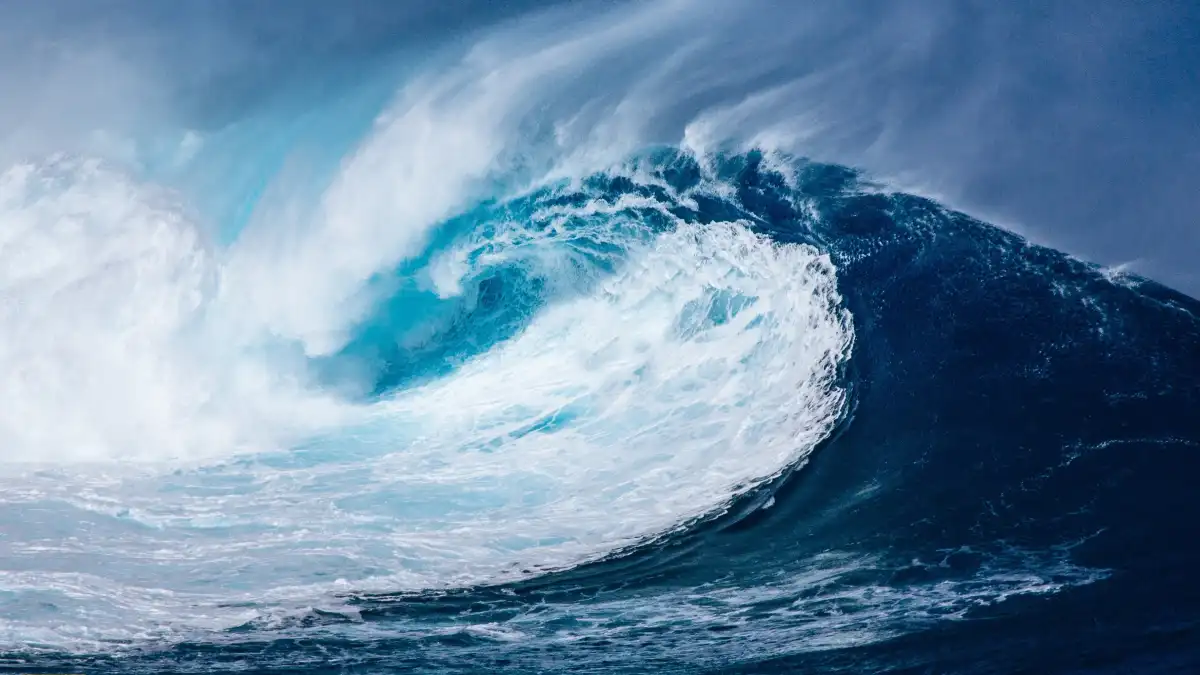Ancient Cities, Acid Seas, and the Gospel of Climate Panic
I grew up on stories of ancient aliens. Yes, really. Beam-me-up stuff, but with stone tablets and sandalwood. My father was a devoted disciple of the Swiss space-evangelist Erich von Däniken—the man who brought ancient astronaut theory to a paperback rack near you.
Now, my father wasn’t a scholar. He was born just before World War II came goose-stepping through Austria, and when survival’s on the syllabus, philosophy tends to get bumped. But a lack of formal education didn’t make him dull. On the contrary: it sharpened his imagination like a prison shiv. He didn’t have a grand theory—just a hunch. A glimmer of something behind the curtain. A missing chapter no one was meant to read. Or maybe he just preserved the kind of childlike wonder only someone robbed of a childhood can. We’ll never know.
Back to Däniken. He jet-setted across antiquity looking for evidence that the gods were just astronauts in funny hats. That’s how I first encountered the Nazca lines, etched into the Peruvian plains like airfield runes. Or the peculiar architectural anomalies of the pyramids, which still make modern engineers sweat. But cracks soon formed in the tinfoil. If the aliens had come, why hide? Why leave cryptic doodles instead of, say, a user manual?
This post first appeared in 2020, back when I still entertained hope that rational arguments might sway public sentiment. I’ve since remastered it—sharpened the edges, clarified the threat, and realigned it with the Grimwright ethos: use what works, discard the rest, and always—always—question the narrative. The date remains unchanged as a historical marker. The content does not.
Still, the places lingered in my mind, sticky and strange. And the stories. Däniken must have pored over scrolls and scripture until his eyes went dry, chasing E.T. through ancient footnotes. That’s how I learned about the celestial brawl between the Hindu god Krishna and the rather un-neighborly King Salva.
Their battlefield? The ancient city of Dwarka, perched on the edge of the Arabian Sea. The Mahabharata—one of those Sanskrit sagas that makes Homer look like Twitter—claims Salva came roaring in aboard a flying machine, hurling what we might diplomatically call “energy weapons.”
Krishna, being a god, retaliated with arrows that thundered and glowed like solar flares. Naturally, Dwarka has become something of a pilgrimage site for ancient alien hobbyists.
A quaint tale, right? Obviously just mythology.
Except—between 1983 and 1990, Indian marine archaeologists dredged up the ruins of ancient Dwarka… underwater. Right where the old epic said it would be. Built just as described. Submerged not recently, not post-SUV, but some 5500 years ago. Long before Climate Change™ made its theatrical debut.
Nietzsche would’ve smirked. Once again, the rock-solid consensus of Science™ dissolves like cotton candy in history’s mouth. Sea-level rise didn’t wait for coal-fired plants or SUVs—it drowned Dwarka when humanity was still bumbling through the Neolithic.
And Dwarka’s not alone. There are sunken cities all over this spinning orb. Some fell victim to volcanoes, others just… sank. Slowly, inexorably. The sea crept in like an old tax bill. Around Dwarka, evidence suggests the entire coastal shelf began its descent as far back as 9000 BCE. Not a sprint—more of a 10,000-year tiptoe into the drink.
Sea levels change. Always have. Land shifts. Continents drift, crack, subduct. At school, we’re fed the plate tectonics primer and told that’s the end of the story. But the Earth isn’t just floating geometry. Sediments pile up. Coastlines evolve. The Sumerians described sea-hugging ports that now lie deep inland. The Euphrates and Tigris slowly exhaled the land that pushed those cities away from the sea. Herodotus noted the Nile delta expanding like a lazy oozing beast into the Mediterranean. Thousands of years ago, this was common knowledge.
Elsewhere, whole coasts have vanished like Atlantis—which, incidentally, also belongs on the long list of places dismissed as fairy tales until proven inconvenient.
So if coastlines have always moved, why the panic? What makes today’s ebb and flow sacrilegious?
Enter the Church of Climate Alarmism. Their gospel is simple: humans burn stuff, planet gets hot, ice melts, seas rise, coasts drown, shame on you. It’s the bathtub theory. Add heat, ice becomes water, water goes up. Simple.
Too simple.
But theological simplicity is the lifeblood of orthodoxy. Today’s climate clerics care less about thermodynamics than about heresy. Speak the creed, get the grant. Doubt it, and you’re branded a denier, exiled from polite discourse like a medieval leper muttering truths outside the village gates.
And don’t you dare quote inconvenient data. Heresy, all of it. The priesthood will banish you faster than a Galileo in a telescope store. If you’ve read Orwell’s Animal Farm, you already know the drill.
But there’s more. According to the catechism, the warming planet doesn’t just make water rise—it makes it warmer and more acidic. And that, dear flock, is apparently apocalyptic.
Let’s talk acidification. First, the term is a linguistic swindle. The oceans are not acidic. They’re alkaline—pH 8 on a scale where 7 is neutral. That’s a comfortable notch on the basic side of things.
Now back to chemistry class. Mix an acid with a base? You get neutralization. Not doom, not death—just boring old balance. If you drizzle a little acid into a big pool of base, you don’t get acid. You get… slightly less base. 8 becomes 7.92. Cue dramatic music.
CO₂ mixes with seawater and forms a weak acid. In theory, this could erode the shells of marine creatures. But here’s the rub: the change is microscopic. The ocean doesn’t become acidic—it becomes marginally less alkaline. No shell-melting apocalypse. No acidic nightmare. Just decimal points adjusting their tie.
Paracelsus, godfather of toxicology, would be spinning in his grave. “The dose makes the poison,” he preached. Today’s climate clergy reverse it: the panic makes the poison. We’ve traded fact for optics. Feeling trumps knowing. Drama replaces data.
But “acidification” sounds scary. It’s got that whiff of catastrophe. So it sticks, whether it fits or not.
Still, warming waters—those are real, right?
We’re told corals bleach and die as seas heat up. A tragedy. A warning sign. The reefs are dying, we’re told, and it’s our fault.
But if corals are that sensitive, how did they survive history?
The Roman and Medieval Warm Periods were hotter than now. The Holocene Climate Optima were hotter still, stretching for centuries. If corals couldn’t take the heat, they should’ve vanished long ago.
Yet they didn’t.
Corals strolled through the Jurassic, sunbathed in the Eocene, and held their own through planetary traumas that make today’s headlines look like mild indigestion. But now, supposedly, they’re too fragile to cope.
Take the Chazy Reef in Lake Champlain—it’s 480 million years old. That’s older than the dinosaurs by a quarter-billion years. When it formed, Earth was a sauna. Average temperatures were ten degrees higher than today. And somehow, the coral survived. Hell, it flourished.
How?
I’m just asking. Maybe some marine biologist can square that circle. Maybe the answer exists and I simply haven’t understood it yet. But if it can’t be explained to someone who isn’t wearing a lab coat, then maybe it isn’t science—it’s priestcraft.
Until then, I remain skeptical that warming waters are the crisis we’re told they are.
And while we’re at it, let’s wade into another steamy puddle of half-truths.
In January, The Guardian solemnly declared that ocean temperatures hit “a record high.” Ever. Insert dramatic swell.
Let’s unpack that.
They’re talking about changes measured in hundredths of a degree Celsius. Hundredths. And we’re expected to compare those readings with measurements from 1850?
Let’s be serious. In 1850, most thermometers couldn’t agree on the temperature of tea. Never mind oceans. The idea that we’ve got reliable, granular global data from the era of steamships and cholera is pure fiction.
And today? We measure the vast, roiling oceans—which cover over 70% of Earth—with 3,800 free-floating Argo buoys. That’s our great thermometer army. Spread thinly across a planet-sized aquarium.
That’s not science. That’s statistical homeopathy.
Even a few decades ago, we had far fewer sensors. They were wildly less accurate. And before World War I? Practically nothing. A data desert.
Yet somehow, we’re confidently told this is the warmest ocean in 150 years.
Sure. Why not.
We’re Ahab with a thermometer, chasing a statistical whale. Pretending to chart infinity with 3,800 plastic buoys. Borges once warned of a map so detailed it became useless. We’re nearly there—just missing the humility.
We’ve begun to peer into the blackness of space. We’re still just learning what’s out there. But down here, our oceans remain just as alien. Modeling them with scraps of data and padded assumptions isn’t just hubris—it’s madness. The madness of Ahab.




